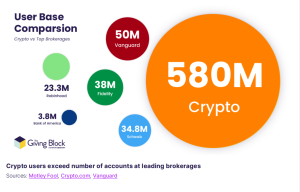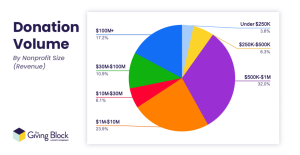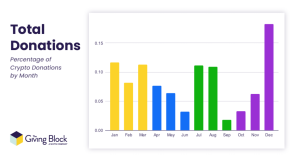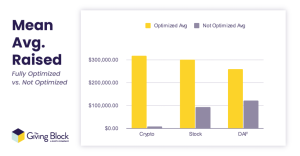Introduction
In the ever-evolving crypto industry, having a supportive crypto community is essential for navigating the financial journey. A community is more than just a gathering place; it serves as a bridge between beginners and experts to share knowledge, engage in discussions, and deepen their understanding of the crypto world. Joining the right community can accelerate the path to success.
The development of crypto communities has been driven by the increasing adoption of cryptocurrencies, both among individuals and institutions. According to a report by The Giving Block, 52% of Fortune 100 companies have undertaken projects related to crypto, blockchain, or Web3 since 2020. About 40% of the younger generation (18–35 years old) plans to use crypto as a payment method. Meanwhile, the number of global crypto investors in January 2024 reached 580 million.

The report also highlighted that 2023 marked the resurgence of the crypto industry after a sharp decline in the previous year. Coinbase ($COIN) surged by over 400%, and Bitcoin prices rose by more than 150%. This momentum created enthusiasm within the crypto community and presented a significant opportunity for crypto philanthropy in 2024.
An increasing number of communities and nonprofit organizations are now ready to harness the potential of crypto fundraising. Communities play a crucial role in strengthening crypto adoption through philanthropy. Philanthropy, or dedication to humanity, involves donating or contributing to public welfare. In this context, philanthropy can take the form of crypto donations, typically aimed at helping those in need, such as nonprofit organizations, charities, or disaster victims.
Through this article, All Spark Research aims to explore growth strategies for crypto communities. The article also highlights key data, current trends, and successful case studies based on The Giving Block’s report. The report explores opportunities, trends, and critical strategies to help nonprofit organizations navigate the world of crypto philanthropy.
Overview of Crypto Philanthropy in 2024
According to the report, crypto donations are estimated to exceed $2 billion by January 2024. Around 56% of the top charities in the U.S. accept crypto donations, and 67.8% of nonprofit organizations actively raise funds using platforms such as The Giving Block.
Each year, more than $2 billion has been donated via crypto to date. With the global crypto user base reaching 580 million, the opportunities for nonprofit fundraising continue to expand. Nonprofit organizations handle a substantial donation volume. A pie chart shows donation volumes based on the size of nonprofit organizations, with the majority coming from organizations earning $500k–$1 million annually.

Several factors underpin the increase in donation volumes from nonprofits that accept crypto. The first factor is that crypto donation options are easy to find, thanks to their strategic placement on websites, events, and fundraising campaigns. The second factor is that they are easy to use, with optimized crypto donation forms that cater to donors of all backgrounds.
Finally, crypto donations are easy to accept due to automation that simplifies the process for nonprofits and addresses challenges like price volatility. In recent years, there has been a significant shift in donation patterns, transitioning from stock-based donations to crypto-based donations. This shift reflects developments in financial technology, changes in donor preferences, and the unique benefits offered by crypto assets.
Crypto donations are influenced by seasonal giving. Unlike traditional end-of-year giving, crypto donations occur throughout the year, with peaks in January, July, August, and December. January is one of the favorite months for crypto donations, as many individuals, communities, and organizations start the new year with goodwill, including increased philanthropic activities.
July and August are known as the “Summer Giving” season. In many countries, summer marks school holidays and the time for numerous social events or charity campaigns. December always sees the highest donation volumes, driven by the holiday spirit and the desire to share during Christmas celebrations. A bar chart shows the percentage of crypto donations by month, with a peak in December and the lowest point in September.

Additionally, crypto market volatility also impacts donation levels. When crypto prices surge, holders are more likely to donate as their assets’ value increases. Organizations often capitalize on specific market trends to launch fundraising campaigns.
Tax deductions are another driving factor for the rise in crypto donations among communities. In the U.S. and the U.K., national revenue authorities provide substantial tax relief for those who donate their crypto to registered charities.
Strategies for Crypto Community Growth
a. Key Catalysts for Growth
More and more nonprofit organizations are starting to accept crypto donations due to donor demand. This indicates that awareness of the potential for philanthropy or crypto donations can still be improved. Nonprofit organizations are encouraged to optimize their crypto donation pages, increase visibility, and create a satisfying user experience on both mobile and desktop devices.
Unfortunately, many nonprofit officials feel less confident discussing crypto donations due to a lack of knowledge. Therefore, education and awareness are key to maximizing this potential.
b. Collaboration with Key Players
Collaboration between communities and key players greatly influences the success of crypto donations. The roles of blockchain companies, NFT creators, and DAOs are crucial in fundraising. Interestingly, many nonprofit organizations are now starting to explore NFT fundraising. Donors can contribute in the form of cryptocurrency or other digital assets like NFTs. NFTs offer a new way to raise funds for charitable causes through digital art auctions.
Successful projects that have accepted NFT donations include Stella Artois (Water.org), NodeMonkes (child cancer research), and reGEN (Alzheimer’s disease). NFTs provide opportunities for communities to invest in social causes through blockchain-based fundraising.
c. Technology Optimization and Integration
The use of mobile-friendly and SEO-optimized crypto donation pages makes communities more comfortable donating crypto. SEO optimization can help organizations, both large and small, gain exposure to potential crypto donors through optimized donation pages.
According to reports, organizations with optimized donation pages collect up to 40 times more crypto donations than those without. Additionally, accepting donations in the form of stocks and DAFs (Donor-Advised Funds) alongside crypto creates more opportunities for fundraising.
The integration of crypto donation methods can be achieved with ease of access. Integrated donation forms for stocks, crypto, and DAFs simplify the process for donors, reduce barriers, and increase donor retention. The bar chart below compares the average fundraising results for optimized and non-optimized categories: Crypto, Stocks, and DAF. Optimized Crypto shows the highest results.

Integrating various donation methods into websites is also critical to reducing friction in the donation experience. Nonprofit organizations that adopt these strategies and integrations will be better equipped to compete in the modern fundraising landscape, with greater capacity to maximize non-cash asset donations.
Case Study: Crypto Philanthropy
a. Maui Wildfire Relief (2023)
In 2023, the crypto community, led by Ripple and Jared Isaacman, donated to the Maui Wildfire Relief efforts. The community successfully raised $1 million for the Maui Emergency Response Fund.
b. Orangutan Outreach
Web3 communities, such as the Bored Ape Yacht Club, provided support in the form of donations for wildlife conservation. They utilized video-based marketing strategies and mobile platforms. Thanks to the NFT donation campaign, the regenerative farming nonprofit Trees for the Future managed to plant 2.3 million trees.
c. The Water Project
The Water Project has transformed lives by providing access to clean water through crypto donation campaigns, starting with contributions from the Pineapple Fund. This donation initiative successfully improved clean water access in Sub-Saharan Africa. Uniquely, this project used a Year-End Toolkit Approach to boost community and donor engagement.
d. Save the Children
Save the Children became one of the pioneers by raising over $7 million in crypto donations and developing a continuously growing fundraising program. An inclusive strategy was successfully implemented to build loyalty among crypto donor communities.
e. Memecoin: Entertainment with Social Impact
Communities such as DOGE and Shiba Inu leveraged their collective power for philanthropic purposes, including charity fundraising through smart contracts. Projects like Baby Doge have donated nearly $500,000 to animal shelters, demonstrating how memecoins can serve as a positive force in the world of charity.
Challenges and Opportunities
The lack of knowledge about crypto among nonprofit organizations can hinder the process of crypto donations. Education is essential to increase the knowledge of nonprofit managers, providing them with broader insights into crypto. This can offer a wider perspective on crypto, enabling them to identify various philanthropic strategy options.
Dependence on the fluctuation of crypto values also poses another challenge, especially for crypto donors using Bitcoin or Ethereum. The volatile nature of crypto assets can cause the amount of donations to change significantly within a short period.
In addition to challenges, there are also opportunities in crypto donations. One of these opportunities is the development of more educational programs about crypto. Education and active discussions with crypto communities worldwide, both online and offline, aim to reach donors and investors from various backgrounds. These educational activities can include Q&A sessions, group discussions, and investment training.
The integration of Web3 can enhance the potential growth of crypto donations. Through partnerships between communities, donors, and beneficiaries, all parties can interact within a transparent and secure digital ecosystem. This not only increases trust and participation in charitable initiatives but also opens doors for innovation in the way aid is given and received.
Future Predictions for Crypto Philanthropy
Crypto philanthropy will increasingly focus on strengthening the global community. This will be achieved through blockchain transparency and automated fund management. This technology enables donors to monitor the use of funds in real-time. Additionally, donors can build trust and community engagement in supporting shared social goals.
The use of NFTs in philanthropy expands community access. NFT-based donations allow communities to participate creatively while supporting social projects. Collaboration between crypto communities and traditional institutions can create more inclusive and impactful philanthropic models.
Community-based education and innovation position crypto philanthropy as a major force for global change. With the advancement of technology, community enthusiasm, and wider acceptance, the future of crypto-linked philanthropy looks promising.
Conclusion
The crypto community has significant potential to drive global philanthropy toward a more inclusive and efficient direction. By leveraging blockchain technology, adopting educational strategies, and building collaborations with key players in the ecosystem, nonprofit organizations can overcome challenges while maximizing opportunities.
The case studies presented demonstrate that innovations in crypto fundraising not only positively impact society but also strengthen the relationship between the crypto community and philanthropy. In the future, crypto-based philanthropy is predicted to continue growing. Crypto donations are becoming a key element in building a better world through modern technology.

